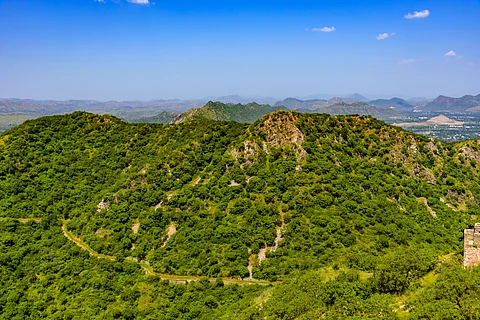
- Destinations
- Experiences
- Stay
- What's new
- Celebrating People
- Responsible Tourism
- CampaignsCampaigns
- SubscribeSubscribe
- Buy Now

On World Environment Day 2025, Prime Minister Narendra Modi marked a significant milestone in India’s environmental conservation journey by re-launching the ambitious Aravalli Green Wall Project—a large-scale reforestation drive aiming to restore the 700-km Aravalli mountain range that spans across Delhi, Haryana, Rajasthan and Gujarat.
The launch of the initiative on June 5 saw the active participation from the chief ministers of the four states, emphasising a united front in addressing environmental challenges. The government plans to continuously support nursery development and large-scale planting drives, ensuring the long-term health and sustainability of the Aravalli range.
As part of the ongoing “Ek Ped Maa Ke Naam” (“One Tree For Mother”) campaign, Modi planted a sapling at the Bhagwan Mahavir Vanasthali Park in Delhi, symbolising a renewed commitment to environmental sustainability. Here’s what you need to know about the initiative.
The Aravalli mountain range is likely India’s oldest mountain range, spanning 692 km and running southwesterly from Delhi to Gujarat. It boasts 22 wildlife sanctuaries, including four tiger reserves and bird parks. The mountains recharge important rivers like the Chambal, Sabarmati and Luni, and they are a vital ecological barrier that prevents the eastward expansion of the Thar Desert.
Surveys by a Wildlife Institute of India (WII) team in parts of Gurugram, Faridabad, Mewat, Mahendargarh and Rewari revealed the presence of at least 10 mammalian species like the common leopard, striped hyena, golden jackal, grey wolf, Indian fox, jungle cat, grey mongoose, small Indian civet, Indian crested porcupine, Indian hare, wild pig, rhesus macaque, nilgai and chinkara. The Aravallis host over 300 species of birds due to their location along the Central Asian Flyway, an important migration route.
However, decades of deforestation, mining, livestock grazing and human encroachment have severely degraded this ancient landscape. Nearly 42 per cent of the 6.45 million hectares within the project’s five-km buffer zone suffers from land degradation—81 per cent in Rajasthan alone. This has led to drying lakes, damaged aquifers, reduced biodiversity and increasing desertification risks.
Launched initially in March 2023, the Aravalli Green Wall Project focuses on afforestation, reforestation and the restoration of water bodies across 29 districts in four states and the National Capital Territory (NCT) of Delhi.
The project proposes to establish a buffer zone covering 6.45 million hectares around the Aravalli range. Restoration of the landscape will follow an integrated approach, focusing on improving forest cover, restoring grasslands, managing livestock, and enhancing water systems through traditional and scientific methods.
Specific interventions will include planting native species in degraded forests, fostering savannah-like ecosystems in grasslands, and utilising water conservation techniques to restore grasslands and preserve moisture. The plan's key focus areas include wildlife corridors and water catchments. Community institutions, civil society organisations and state agencies will collaborate to implement the same.
The plan recommends the planting of 42 local species in Delhi. These include: khair, ronjh, desi babool, bael patra, dhau, neem, amaltas, goolar and peepal.
In a nutshell, the project aims to:
Increase biodiversity across the mountain range
Improve soil fertility and water availability
Curb dust storms and halt desertification
Expand green cover in a five-km buffer zone along the Aravalli range
Develop around 1,000 nurseries to support continuous plantation drives
Generate employment and income opportunities for local communities.
Modi emphasised that the project will use innovative plantation techniques, especially in urban and semi-urban areas with limited space, and that all plantation activities will be geo-tagged and monitored via the Meri LiFE portal to ensure transparency and effectiveness.
Beyond ecological restoration, the Aravalli Green Wall Project envisions transforming the region into a thriving hub for eco-tourism and sustainable travel. It plans to do this by:
Developing nature parks and wildlife safaris
Creating trekking trails and adventure tourism circuits
Encouraging community-led tourism initiatives that support local livelihoods
Removing invasive species and replanting native flora to revive natural habitats.
India has committed to reducing the intensity of carbon emissions in its GDP by 45 per cent by 2030. This project aligns with India's climate goals by:
Creating an additional carbon sink of 2.5 to 3 billion tonnes of CO₂ equivalent by 2030
Restoring 26 million hectares of degraded land across the country
Enhancing biodiversity and protecting endangered species
Significantly reducing air pollution in northern India’s urban centres.
(With inputs from multiple news reports)
